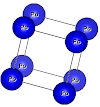+++++++++++++++++++++++++++++++++++++++++++ Dear Wien2k users,I get always confused while bridging from Physics to Chemistry in explaining "spin" and "Magnetism". So, I would be highly appreciated if anybody kindly equalized (if it is possible)in DFT the concepts like "Nonmagnetic", "Paramagnetic", "Ferromagnetic", "Anti-ferromagnetic" and "Ferrimagnetic" in one hand and "Closed shell", "Open shell", "Spin restricted" and "Spin unrestricted" configurations in the another hand, specially in the case of infinite system like an usual bulk (magnetic or nonmagnetic) which is possible to be easily treated in a plane wave code like Wien2k.
To start, I can just say: doing a non-spin polarized calculation in for example Wien2k (run_lapw) equals to a "Closed shell" calculation.
And also, for me a "Ferrimagnetic" looks like a "Spin unrestricted" configuration ... .
Best regards, Salman Zarrini
It is a bit beyond the topics of the mailing list, but I still will try to contribute to your understanding hoping that I'm not getting oversimplifying:
The terms "closed" and "open" shell in atoms/molecules usually means that you have only paired electrons (each atomic/molecular orbital is occupied by a spin-up AND dn electron), or also unpaired electrons. From this definition it is also clear that any atom/molecule with an odd number of electrons will be open-shell, and in an open-shell systems there is a net spin-magnetic moment since the number of up/dn electrons is (usually) different). In a bigger molecule you could have several unpaired electrons in different MOs, but the be arranged in different ways in spin-up or dn, and one usually classifies them by specifying the "spin-multiplicity"
Also in a solid you can have unpaired electrons (take the metals Fe or Cr), but then these "open shell" solutions may differ in the way they have long-range order (something that does of course not exist in molecules). If the spins on all atoms point into the same direction, we speak about a ferromagnet (Fe), but they could also be antiferromagnetic (spin-up on one atom, spin-dn on the next,...) or even more complicated (spin-spirals, non-collinear (or canted), .... Cr you can consider as AFM (although, actually it has a long spin-spiral...). So for AFM-Cr we do a "spin-unrestricted" calculation with a total singlet (zero) spin/unit cell), while for ferromagnetic Fe the total spin is non-zero (note, Fe has a NON-INTEGER spin-moment of 2.2 uB, something which does (to my knowledge) not exist in a finite system.
And last but not least, an Antiferromagnet in "MO"-language is a system where there are more occupied orbitals of spin-up on atom 1; but more of spin-dn on atom 2. Or if you like: When we do the O2 molecule in a periodic code using a big supercell, the triplet O2 molecular state is a "ferromagnet", while the singlet state would be an antiferromagnet.
The terms "closed" and "open" shell in atoms/molecules usually means that you have only paired electrons (each atomic/molecular orbital is occupied by a spin-up AND dn electron), or also unpaired electrons. From this definition it is also clear that any atom/molecule with an odd number of electrons will be open-shell, and in an open-shell systems there is a net spin-magnetic moment since the number of up/dn electrons is (usually) different). In a bigger molecule you could have several unpaired electrons in different MOs, but the be arranged in different ways in spin-up or dn, and one usually classifies them by specifying the "spin-multiplicity"
(singlet, duplet,triplet,...)And last but not least, one can make an approximation restrict spin-up and dn-orbitals to be the same or not (restricted/unrestricted).
In solids things are a bit different:If all electrons are paired and we have an insulator/semiconductor, we talk about a diamagnet (="closed shell") and it implies again that the number of electrons is even. However, in contrast to atoms/molecules, we can have a paramagnetic METAL, which can have an odd number of electrons and still the up and dn-electrons are equal. This is a consequence of the large ("infinite") number of atoms in a 3D solid and the resulting delocalization of the electronic states, so that ONE atom may have only a small fraction of an electron in a particular "orbital" (better a Bloch-state). So the Na atom is a open shell system with 1 unpaired electron, while metallic Na is a paramagnet (and we do run_lapw, i.e. forcing equal number and orbitals for up and dn spin).
Also in a solid you can have unpaired electrons (take the metals Fe or Cr), but then these "open shell" solutions may differ in the way they have long-range order (something that does of course not exist in molecules). If the spins on all atoms point into the same direction, we speak about a ferromagnet (Fe), but they could also be antiferromagnetic (spin-up on one atom, spin-dn on the next,...) or even more complicated (spin-spirals, non-collinear (or canted), .... Cr you can consider as AFM (although, actually it has a long spin-spiral...). So for AFM-Cr we do a "spin-unrestricted" calculation with a total singlet (zero) spin/unit cell), while for ferromagnetic Fe the total spin is non-zero (note, Fe has a NON-INTEGER spin-moment of 2.2 uB, something which does (to my knowledge) not exist in a finite system.
And last but not least, an Antiferromagnet in "MO"-language is a system where there are more occupied orbitals of spin-up on atom 1; but more of spin-dn on atom 2. Or if you like: When we do the O2 molecule in a periodic code using a big supercell, the triplet O2 molecular state is a "ferromagnet", while the singlet state would be an antiferromagnet.
ٌReference: https://www.mail-archive.com/wien@zeus.theochem.tuwien.ac.at/msg11320.html







![LDA+U+SO: NiO: NaCl structure, A-type AFM along [111]](https://blogger.googleusercontent.com/img/b/R29vZ2xl/AVvXsEgYHT5zuCd3c212SJHBf5vGlUsI5WzUq44G5lOTLURS-f3MTNr_pko0OlCiGzHEEH4MxlbTI4V-9VhBUzvtOQB6TAW3TT0aixEylxH0FkB46PAdmDeoXuYeid9TGNjXmsxGbNEtmyPoAlw/w100/AFM.png)


0 Comments